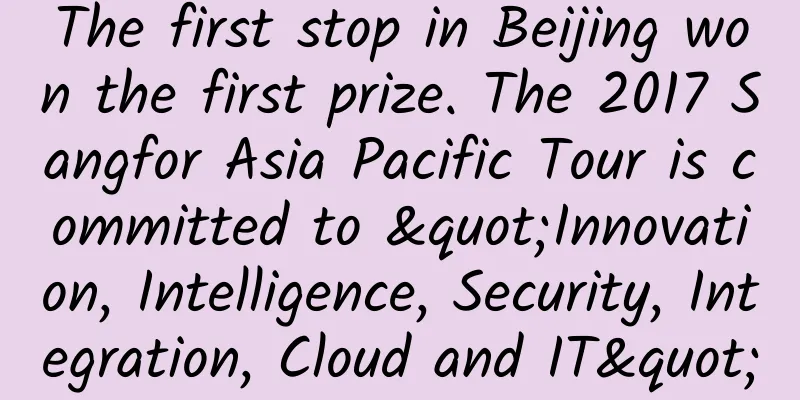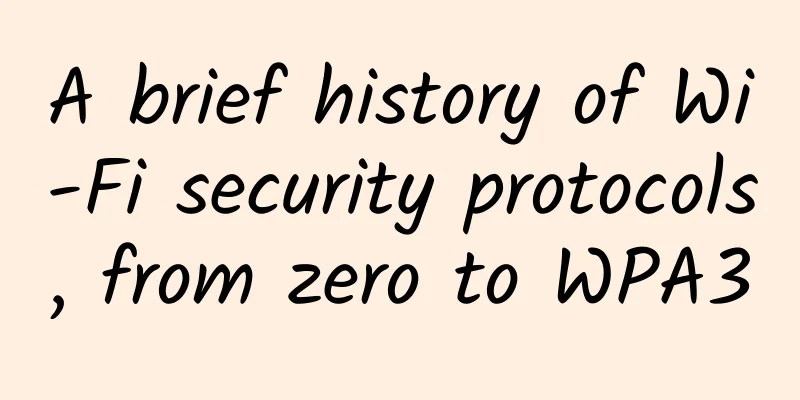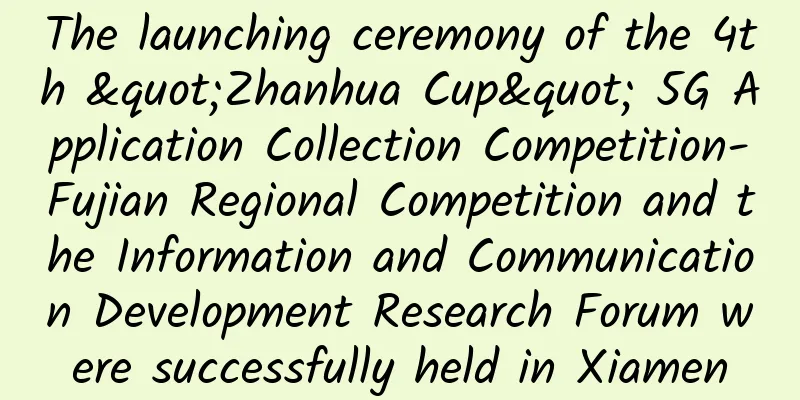The first stop in Beijing won the first prize. The 2017 Sangfor Asia Pacific Tour is committed to "Innovation, Intelligence, Security, Integration, Cloud and IT"

|
[51CTO.com original article] On March 30, the 2017 Sangfor Asia Pacific Tour kicked off in Beijing, with thousands of people in the venue. This year's tour was themed "Innovation, Intelligence, Security, Integration, Cloud IT", interpreting the latest IT trends and business demand changes in the security and cloud computing fields, and proposing Sangfor's business philosophy of making IT simpler and innovative solutions. Sangfor CEO He Chaoxi delivered a speech He Chaoxi, CEO of Sangfor, revealed that this year's tour will be held in more than 150 cities in the Asia-Pacific region. Sangfor will share its latest innovations and best practices in security and cloud computing with its partners and corporate customers, while listening to demands and feedback from all walks of life. Simplifying complex security challenges
Zhang Kaiyi, Vice President of Sangfor Group, delivered a speech Zhang Kaiyi, Vice President of Sangfor Group, said in his speech that in recent years, enterprise IT business has shown three obvious development trends, namely: Internet, mobility and cloud. These three directions are not separated from each other, but combined with each other, and have an increasingly profound impact on the business development of enterprise users. Under these three trends, Sangfor has found that security and IT infrastructure are undergoing important changes: as businesses become more connected to the Internet, enterprise businesses have more external connections, data assets have become more important, and the security risks of enterprise customers have become higher. In addition, as enterprise businesses become cloud-based, applications and data are highly concentrated, and IT departments are more concerned about security needs. "People usually think that computing, storage, and networks are IT infrastructure, and security will definitely become the fourth infrastructure. Any business system construction needs to have these four basic elements." Indeed, the changes in security are very obvious. First, the traditional network boundaries are disappearing, and enterprises need to rebuild new security boundaries. Second, visibility has become the foundation of all security. Third, the focus of security will shift from protection to continuous detection and rapid response. Fourth, the delivery method and delivery interface of future security solutions will become simpler and easier to use. "In the past, we believed that the focus of security protection was to prevent intrusions, but in the future, security protection will also include detection and response." Zhang Kaiyi concluded. So how do we deal with these security challenges? Zhang Kaiyi believes that security solutions need to be simpler and easier to use from delivery, management to maintenance. He said that data shows that nearly 20% of security issues are caused by incorrect product configuration, which shows that the simplicity and ease of use of security products are very important. Similarly, sufficiently friendly security products and simple service processes can speed up people's effective control and response to security incidents. "Through research with professional research institutions, we found that users' essential needs for IT infrastructure and facilities have never changed: simple, stable, secure, and easy to use." "Software-defined" is the future of IT infrastructure Zhang Kaiyi also talked about the changes in IT infrastructure. In the traditional IT infrastructure model, computing, networking, and storage are clearly layered, and security devices or business optimization devices are deployed at the same time. When an enterprise needs to launch a highly reliable business system, the IT department needs to adjust a lot of hardware equipment to support it, and the system deployment cost is very high. More importantly, once a new system needs to be launched, or the core system needs to be expanded, these architectures need to be changed, expanded, and adjusted, which poses a great challenge to system elasticity. Internet companies are the ones who feel the most pressure. In the data centers of public clouds such as Amazon and Google, there is a common feature that they can easily achieve elastic expansion and use distributed storage. In order to adapt to future changes, traditional IT infrastructure must become elastically scalable and available on demand like these public cloud data centers. He said that the new IT infrastructure must be future-oriented and be able to continuously upgrade with the development of business and technology. For example, there will be the evolution of container technology and the need for automated operation and maintenance in the future. "Sangfor believes that the IT architecture of large and medium-sized customers will adopt a hybrid cloud deployment method in the future, so IT vendors also need to help customers achieve unified management and unified collaboration across clouds." Zhang Kaiyi emphasized that these goals can only be achieved by delivering them in a software-based manner. The reason why the software-defined technology, which has been popular in recent years, can meet the needs of the entire business infrastructure is mainly because it is achieved through the joint iteration of a series of technologies such as virtualization technology, chip technology, and flash memory technology. "We believe that software-defined technology will become the future of IT infrastructure." Understand the value of innovation Sangfor's innovative ability leaves a deep impression on people. The reporter learned that Sangfor will invest 20% of its annual operating income in research and development, which is a very high proportion in the industry. In addition to basic investment, Sangfor has also established many mechanisms to encourage innovative breakthroughs, continuously strengthen the continuous tracking and understanding of customers, and prompt the R&D department and the entire planning system to continue to pay attention to customer needs and innovate. It is understood that Sangfor's R&D supervisors and planning managers visit customers more than three times a month to collect their actual needs. More than 10,000 valid needs are collected each year. These needs will be quickly transformed into new versions or new products after internal reconstruction. For example, the world's first IPSec/SSL two-in-one VPN gateway, the creation of the Internet behavior management category, the first domestic launch of the next-generation firewall, the first to deploy network virtualization in a hyper-converged architecture... These innovative achievements are all due to Sangfor's innovation mechanism. In Sangfor's view, innovation is a continuous process, and more importantly, its results will be valuable to customers. For Sangfor, innovation, such as online behavior management products, will be launched in different years to meet customers' different Internet management needs, and constantly innovate to meet customers' new needs. At the conference, Sangfor not only arranged for the heads of relevant product and technology departments to speak, but also invited Sangfor users to speak on site. The presence of two special people also caused cheers from the audience: two-time Olympic champion and world boxing champion Zou Shiming and 2016 Rio Olympics badminton men's singles champion Chen Long, who endorsed Sangfor's security business and cloud IT sub-brands respectively. As Sangfor's exhibition ambassadors, they interpreted the same spirit of "chasing dreams and climbing to the top" as Sangfor people.
Outside the conference hall, there were not only important product lines of Sangfor on display, but also solutions from its partners. Interested exhibitors surrounded the booth, which also made the reporter feel people's desire to use IT technology for business innovation. 14 years ago, Sangfor held its first technical seminar in Shenzhen. Today, Sangfor has grown from a few dozen people to more than 3,000 people, and has transformed from a seminar to an Asia-Pacific tour. More than a decade of changes have not changed Sangfor's original intention: these people are still paying attention to the most real needs of users and making the most practical products. In the eyes of the reporter, it is not easy to stay true to the original intention. In the future, we look forward to seeing more stories of Sangfor helping users improve IT value. [51CTO original article, please indicate the original author and source as 51CTO.com when reprinting on partner sites] |
<<: Pre-5G era: scenarios where Wi-Fi is still indispensable
>>: In 2017, the industry cloud finally became a big thing. It is not as simple as cloud + industry!
Recommend
HostYun Russia CN2 GIA is now available for internal testing with a 10% discount and monthly payment starting from 25.2 yuan
HostYun recently launched a new VPS in Russia CN2...
80VPS: Los Angeles VPS starts at 199 yuan per year, 8C (237 IP) cluster server starts at 800 yuan per month
80VPS is a long-established Chinese hosting compa...
Dapr Practice in Alibaba Cloud Native
What is Service Mesh? Since 2010, SOA architectur...
Do you know how to debug Modbus protocol?
[[386743]] The Modbus protocol adopts master-slav...
Six major trends in 5G development in 2021
2020-12-31 09:392020 is a year of vigorous constr...
Can IPFS subvert the HTTP protocol?
How many people knew about IPFS before August 201...
Why are operators competing to launch new 4G packages as 5G is the mainstream?
[[406115]] In 2021, when 5G is rapidly popularize...
Cyber Security Awareness Week丨Ruishu Information explains how to ensure data security?
It has been one year since the Data Security Law ...
ADLINK and Wind River Systems establish joint lab to focus on remote integration and testing of NFV solutions
[51CTO.com original article] On February 16, 2017...
Do you know several commonly used communication methods in microservices?
introduction Microservice architecture has become...
Countries around the world are competing to develop 5G network DSS technology, causing controversy
After the 5G standards were frozen, the global in...
Some operators have begun to reduce the frequency of 2G networks. What should users who still use 2G phones do?
Recently, there was news that China Unicom will s...
State Council: Promote broadband "speed increase and fee reduction" to improve people's "sense of gain"
The State Council Executive Meeting reviewed and ...
What do you think the sequence number of a TCP reset message is?
This article is reprinted from the WeChat public ...
Xiaoyu Yilian's full range of new products are officially released to ignite the nuclear fusion of the audio and video conferencing industry
On August 2, the 2017 Xiaoyu Yilian E=mc² new pro...









